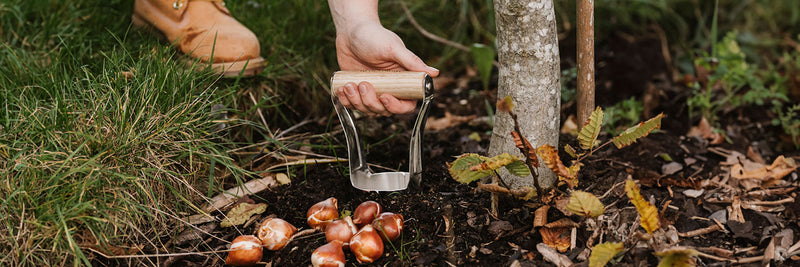Once you’ve chosen your bulbs, it’s important to think about how you can give them the best start in life.
Bulb planting tools are specially designed to make planting bulbs quicker, easier, and more precise. Unlike trowels or spades, they create neat, uniform holes at the exact depth needed, helping to ensure even flowering and healthy plant growth. These tools are particularly useful when planting multiple bulbs, as they speed up the process while reducing strain on your hands and wrists. With better accuracy, consistency, and efficiency than general purpose tools, bulb planters are a must-have for any gardener looking to achieve professional-looking results with less effort.
We have plenty of tips and advice to share, as well as a range of our favourite bulb planting tools to make uniform planting quick and easy.
Choosing the Right Bulb Planting Tools
First, start by using a hand fork to weed and loosen the soil. Once you’ve prepared the area to plant and have decided where each bulb is to be positioned, it’s time to get digging. The key is to ensure bulbs are planted at the correct depth; this will ensure they provide a great display and, in many cases, thrive year after year. Bulbs that are too shallow often fail after the first year, while those planted too deeply may only produce foliage or not emerge at all. The general rule of thumb is to plant your bulb at approximately three times its height (though there are some exceptions).
There are several bulb planting tools available, and we have selected the best one for each type of bulb below. Once you have made uniform planting holes and placed the bulbs in the soil, you can then backfill the holes using a hand trowel.
Our Planting Tools
Kent & Stowe has a wide range of bulb planting tools, from long handled to transplanting trowels, as well as small and standard size hand bulb planters – all designed to make planting an easy and enjoyable task. Shop our full range here.
- Small Bulbs Planter
- Hand Bulb Planter
- Long Handled Bulb Planter
- Dibber
- Widger
- Hand Fork
- Hand Trowel
- Transplanting Trowel
- Potting Scoop

Don’t Forget Gloves
It’s advisable to wear gardening gloves, because bulbs such as hyacinths can cause skin irritation. We recommend either our Sure & Fit Multi Job Gloves, Bamboo Gloves or Premium Seed and Weed. These different kinds will give you the most amount of grip and great dexterity. They are available in both ladies' and men’s sizes, as well as a range of colours.
Bulb Advice
Below are some of the most popular garden flower bulbs with dedicated planting advice.
Allium
When to plant: September to October
Planting depth: 3 times their depth, usually 15-20cm deep
Soil type: well-drained
Preferred position: full sun and sheltered
Planting tool: Large Hand Bulb Planter or Long Handled Bulb Planter

Crocus
When to plant: September to November for spring-flowering crocus, or July to August for autumn-flowering kinds
Planting depth: 3 times their depth, or 10cm
Soil type: well-drained and gritty
Preferred position: full sun
Planting tool: Small Bulbs Planter
Narcissus (daffodil)
When to plant: September to November
Planting depth: 3 times their depth, or 15cm
Soil type: well-drained and moist
Preferred position: sun or light shade
Planting tool: Hand Bulb Planter or a Long Handled Bulb Planter
Hyacinthus (hyacinth)
When to plant: September to October
Planting depth: twice their depth, or 10cm
Soil type: well-drained and moist
Preferred position: full sun
Planting tool: Hand Bulb Planter or a Long Handled Bulb Planter
Tulipa (tulip)
When to plant: November and December
Planting depth: 3 times their depth, or 20cm
Soil type: well-drained
Preferred position: full sun
Planting tool: Large Hand Bulb Planter or a Long Handled Bulb Planter

Galanthus (snowdrop)
When to plant: September to November
Planting depth: 3 times their depth, or 10cm
Soil type: well-drained and moist
Preferred position: light shade
Planting tool: Small Bulbs Planter

Perfect Compost for Bulbs
For planting in containers, we recommend Westland Bulb Planting & Potting Mix. This specialist compost provides the perfect environment for root growth. If you’re concentrating on planting in beds and borders but have heavier soil, it’s best to use some horticultural sand. This will help to break up heavy soil, aiding the establishment of bulbs. Furthermore, you can mix horticultural sand with potting composts to produce a looser, more open structure, preventing root damage to plants that need sharp drainage.












